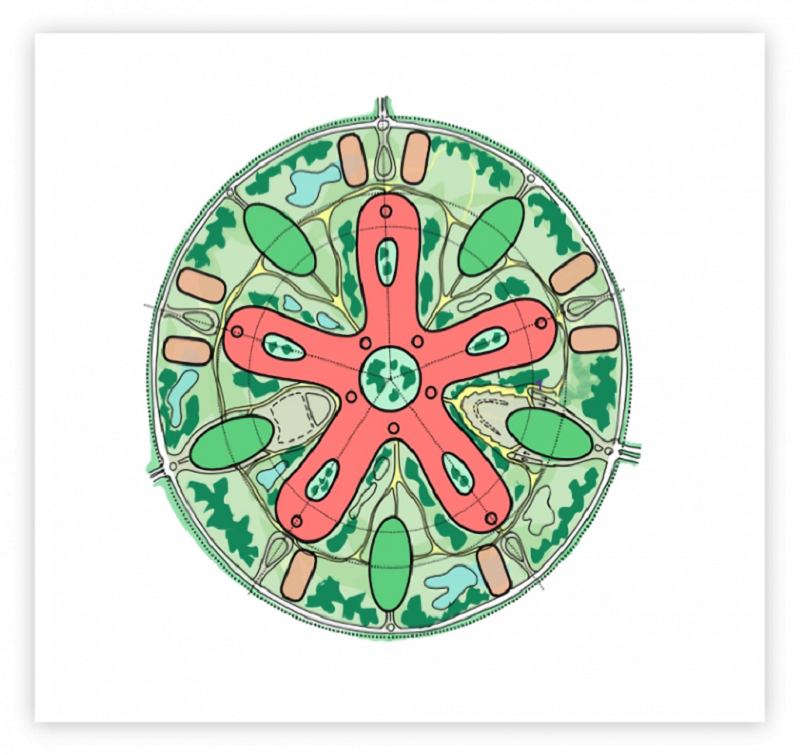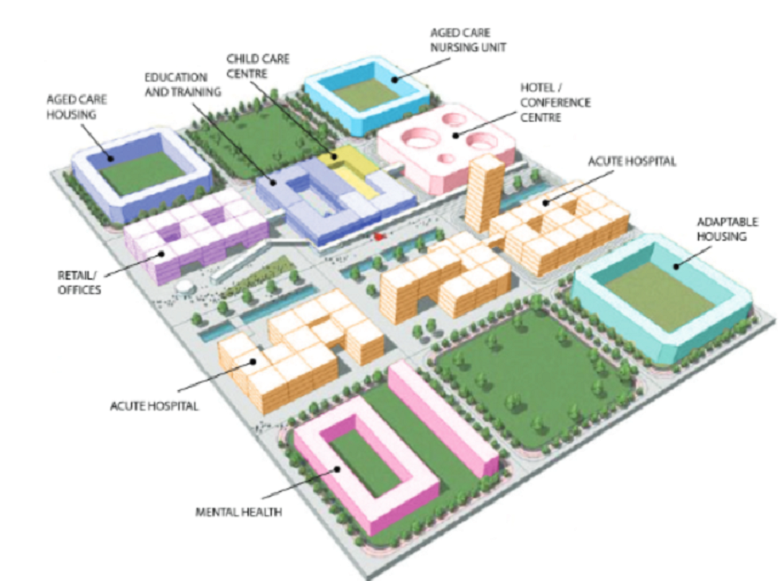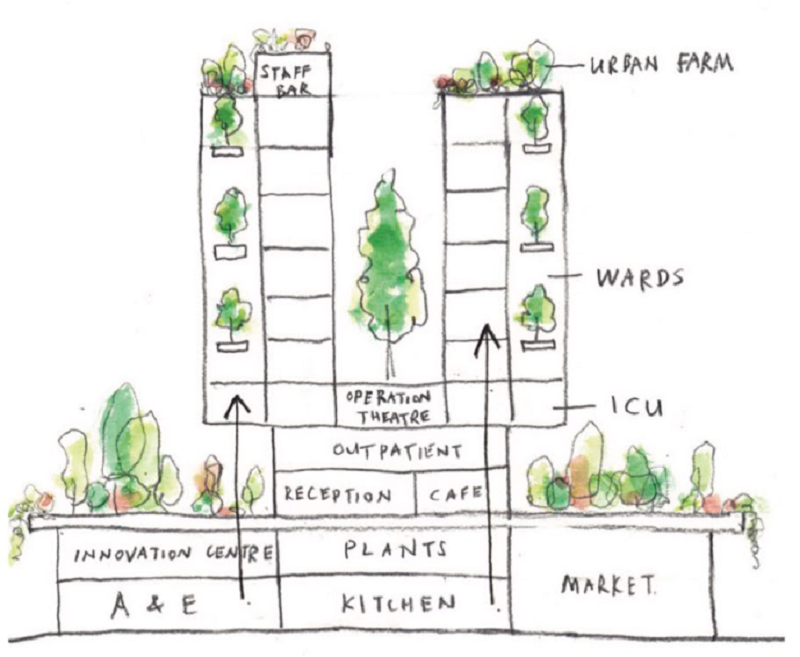Airline-style treatment pods for A&E patients, an urban farm on a hospital roof, and starfish-shaped health hubs are three of the radical new medical centre designs shortlisted for the coveted Wolfson Economics Prize.
The annual £250,000 competition is the second-largest economics prize in the world after the Nobel and invites new thinking to address major economic policy issues.
And this year the judging panel is seeking new hospital design approaches that will radically improve the patient experience, clinical outcomes, staff wellbeing, and integration with wider health and social care services.
This week five entries were shortlisted from more than 250 applications from across 15 countries.
They included submissions from medical staff, architects, and patients.
While NHS hospitals to date have been built largely to treat chronic illness, we must seize opportunities for hospitals to be centres for promoting health and preventing disease as well
The idea of a ‘SMART ED’ was put forward by a team led by Dr Susan Robinson, a consultant in emergency medicine at Cambridge University Hospitals NHS Foundation Trust.
It includes ideas such as:
- 14-minute average waiting times, with patients greeted by a doctor the moment they arrive
- First-class airline-style pods, taking up one third the size of a regular patient room, for those with less-serious conditions
- An automated parking tower for patients who arrive by car
- Private rooms for patients, with separate entrances for staff and visitors that increase flow and efficiency
- Intensity and colour of lights controlled by the patient, with mobile charging points provided
Dr Robinson said: “We have spent many years immersed in conversations about how both design and process are critical for the delivery of safe and effective emergency care, so it was a once-in-a-lifetime opportunity to grasp the challenge offered by the Wolfson Economics Prize to design a new emergency department with the patient and staff as the starting point.
“The prize gave us an opportunity to radically rethink the emergency department using real-world, here-and-now technology and operational concepts that seek to reduce waiting times significantly, provide a safe and efficient work environment, be carbon neutral over its lifecycle, be fiscally responsible, and provide a way of testing new, advanced operational and architectural concepts before they are deployed systemwide.”
St Albans-based economist, Deirdre King, supported by David Leonard of Leonard Design Architects, has also been shortlisted for her idea for ‘starfish hospitals’.
We have spent many years immersed in conversations about how both design and process are critical for the delivery of safe and effective emergency care, so it was a once-in-a-lifetime opportunity to design a new emergency department with the patient and staff as the starting point
The entry proposes a total redesign and modernisation of hospital activity, which would be divided into three settings: Starfish-shaped hospital hubs; satellite specialist health centres; and a ‘hospital at home’.
The starfish-shaped hospitals would divide up five core hospital activities – A&E, diagnostics, operating theatres, ICU and laboratories – into each ‘ray’ of the starfish.
Designed to replace the ‘confusing, impersonal, and unwelcoming’ feel of today’s hospitals and ‘give the sense of welcome you would receive in a five-star hotel’, the entry also proposes and new ‘front-stage/back-stage’ workflow to increase productivity and reduce infection control, plus separate staff and public entrances to a building.
These central hubs – filled with natural light and connected with the outside – would provide acute care, with smaller satellite centres providing non-acute care, such as chemotherapy and mental health treatment.
And the approach would be mirrored by a ‘hospital at home’ to deliver early supported discharge, virtual visits, and assessments.
Other ideas within the submission include automated guided vehicles to transport supplies; a ‘donate a brick’ appeal to help cover the costs of building work; and a volunteering scheme to help maintain green spaces within hospital grounds.

Starfish Hospitals are part of a total redesign and modernisation of hospital activity, which divides care into three settings, including starfish-shaped hospital hubs
King said: “Our big idea is a Starfish hospital, designed for life, with modern hubs, connected rays, and satellites.
“This will empower staff to provide optimal clinical services in a calm and welcoming environment, enhance hospital experiences for all, and offer a vision to build a healthier population.”
She added: “My motivation and inspiration for developing Starfish comes from my heartfelt gratitude to the NHS for saving my life just over 25 years ago when I was one of the first patients to receive pioneering stem cell transplant treatment for advanced Hodgkin’s Disease, and from my hospital experiences as a patient.”
We say bring the next generation of NHS hospitals, and their economic muscle, right back into the centre of town
The third shortlisted entry is a hospital design approach that draws on neuroscience and the symmetry and shapes found in nature.
The team, which includes John Simpson Architects, Ruggles Mabe Studio Architecture + Interiors, and Create Streets and the Create Streets Foundation, argue this can lead to a complete rethink, turning hospitals from ‘factories for fixing’ to ‘places for healing’.
John Simpson of John Simpson Architects, said: “Much recent research in neuroscience is teaching us that our immune system responds to the environment we are in.
“This is why in the past hospitals have always been places of peace and sanctuary where patients feel nourished, and the human spirit can thrive.
“We have identified seven key components essential to the creation of a modern hospital which are capable of transforming patient experiences, clinical outcomes, and staff wellbeing.
“We call this the ‘Complete Hospitals Framework’, which is devised to provide guidance so that modern hospitals can change from the simple factories for fixing we have today to places of healing, able to work alongside the science and technology of medicine to help in the recovery and rehabilitation of patients.”
The location of hospitals has also come under the spotlight.
The fourth finalist aims to bring the hospital back to the town to better serve local communities.
We have identified seven key components essential to the creation of a modern hospital which are capable of transforming patient experiences, clinical outcomes, and staff wellbeing
The Well-Placed Hospital is the brainchild of healthcare planning and management consultant, Andy Black; social care planning and management specialist, Anthony Farnsworth; MAAP Architects; and Fleet Architects.
It includes ideas such as:
- Smaller, more-convivial hospitals in English towns that better integrate health and social care – using the example of re-siting a hospital in Barnstaple, Devon
- Hospitals that better support the local economy
- Bringing GPs into hospitals with the unification of general and hospital medical practice in a single ‘unified clinical faculty’
- Hospitals that reduce the NHS’s carbon footprint by removing the need for car journeys to out-of-town hospitals, recognising that of 268 NHS hospitals in England, perhaps only 30 are within 10 minutes of the town centre
- Moving the substantial element of elderly care into reformed residential nursing home care and housing-for-life units

The Well-Placed Hospital looks at bringing hospitals back into town centres
Black comments: “We say bring the next generation of NHS hospitals, and their economic muscle, right back into the centre of town.
“And integrate hospital and residential nursing care facilities and staff.
“We use Barnstaple as an example, but many other towns could follow the same logic.”
The last entry shortlisted is the Living Systems Hospital, which proposes a green hospital design which takes an innovative, multi-sensory approach, considering the smell and sound of the space inspired by ‘the adaptive qualities of living systems found in nature’.
Submitted by Ab Rogers Design; it includes an in-house marketplace of local produce and a rooftop urban farm, as well as a staff bar, ‘pocket gardens’ between wards, and wards manned by ‘hosts’ whose job it is to look after patients and their visitors.
Rogers said: “Our vision for the hospital of the future is a celebration of health; it nurtures body and mind and cares for the sick, the well, and everyone in between.
Hospitals represent just one element of the wider system, but they are at the heart of an effective care network, a centre of learning, and of course a major employer
“Inspired by the adaptive qualities of living systems, it is a connected and forward-looking institution that grows and changes in response to its environment and the needs of its users.”
The five finalists will now have until the end of October to expand and refine their submissions, before an overall winner will be announced in November.

The Living Systems idea proposes a green hospital design which features a rooftop urban farm, staff bar, and pocket gardens
Commenting on this year’s healthcare focus, chairman of the judging panel, Lord Kakkar, said: “All of us agree that modern hospitals are being designed and planned in the midst of three transformations: changes in technology, including new diagnostics and health data; changes in the model of care, with more focus on multi-disciplinary and coordinated working; and changes in the service user, with the profile of a regular patient increasingly older, frailer, and with more-complex needs.
“And grasping the interplay between these factors is fundamental to a successful healthcare system.
“Hospitals represent just one element of the wider system, but they are at the heart of an effective care network, a centre of learning, and of course a major employer.
“And while NHS hospitals to date have been built largely to treat chronic illness, we must seize opportunities for hospitals to be centres for promoting health and preventing disease as well.
“My fellow Judges and I want to see visionary ideas which challenge the status quo and are compelling, impactful, and deliverable.”
Commenting after the shortlist was revealed, Health and Social Care Secretary, Sajid Javid, added: “Hospitals are an intrinsic part of local communities, helping to save lives and keep people healthy.
“We’re on track to deliver 48 hospitals by 2030, which will give staff the facilities needed to continue providing top-quality care for years to come.
“All our new hospitals will prioritise sustainability, digital technology, and the latest construction methods, delivering state-of-the-art facilities for patients while maximising value for taxpayers’ money.
“And this year’s Wolfson shortlist is packed full of innovative ideas to help inform these plans.”
